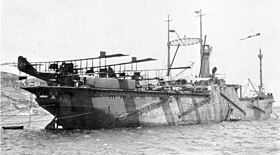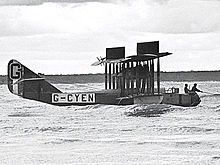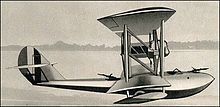Dédalo (ship, 1901)
|
|
|
|---|---|
 The Dédalo |
|
| Overview | |
| Type |
Cargo ship seaplane carrier |
| Shipyard | |
| Launch | May 22, 1901 |
| delivery | October 3, 1901 |
| Namesake | Daidalos , figure of Greek mythology |
| Commissioning | May 1, 1922 |
| Decommissioning | 1935 |
| Whereabouts | Sunk July 18, 1937 |
| Technical specifications | |
| displacement |
9900 ts |
| length |
127.4 m |
| width |
16.8 m |
| Draft |
7.4 m |
| crew |
398 men |
| drive |
4 cylinder quadruple expansion |
| speed |
10 kn |
| Armament |
2 × 105 mm / L35 cannons M.1897 |
| Planes |
until 25 |
| Captive balloons |
2 |
| Airships |
2 |
The first Dédalo of the Spanish Navy was an aircraft mother ship , created through the conversion of the German cargo ship Neuenfels . In service from 1922 to 1935, its aircraft were successfully used against the Rifkabylen in Spanish Morocco in 1925 .
history
The later Dédalo was launched on May 22, 1901 at the Wigham Richardson & Co. shipyard in Newcastle on Tyne . The new building with building number 375 was named Neuenfels and was intended for the German Steamship Company "Hansa" in Bremen .
The freighter Neuenfels
The cargo ship was one of a new series of ships for the East India Service of the shipping company. The Wigham Richardson shipyard delivered four ships of this series in 1901, and three more ships from the Flensburger Schiffbau-Gesellschaft were added from 1901 to 1903 .
The Neuenfels , delivered on October 3, 1901, was the third ship in the series. The ship, measured at 5650 GRT , had a deadweight capacity of 8470 tdw. It was 127.7 m long, 16.8 m wide and had a draft of 6.2 m. Driven by a 4-cylinder quadruple expansion machine from the shipyard with 2200 PSi, the Neuenfels reached 11 knots . The ship was named after Neuenfels Castle on the edge of the Black Forest near the Rheingraben.
The new ships built for the East India service were used on the various lines of the Bremen freight shipping company. In 1914, when the First World War began, none of the seven ships were at home. So were Wildenfels and Scharzfels 1914 in Australia , the lead ship Argentinas rock in Saigon in French Indochina confiscated. These three ships were used as transporters by the Entente Powers , as did the Marienfels and Lichtenfels from 1916 when Portugal entered the war , which had found refuge in Mormugoa in 1914 . The Marienfels was sunk as the Portuguese Diu in 1917 by the German submarine U 57 . The Schönfels spent the war in neutral Sabang in the Dutch East Indies , but had to be extradited to Great Britain in 1919.
In 1914 the Neuenfels found refuge in Vigo, Spain . Before the end of the war in 1918, the Spanish government began negotiations with the German Reich regarding compensation for Spanish ship losses, particularly as a result of the submarine war, and finally confiscated six German ships lying up in Spanish ports . The Neuenfels was taken over on October 22, 1918 as Espana No.6 .
Conversion to the aircraft mother ship
In September 1921 the ship was transferred to the Spanish Navy. From November 1921 it was converted into an aircraft mother ship at the “Talleres Nuevo Vulcano” shipyard in Barcelona . The superstructures were changed and areas of application for aircraft were created. The forecastle was given a large hangar below deck, where two tethered balloons or a semi-rigid airship of the Italian type SCA (1500 m³, 39.3 m long) should find space. A retaining mast was set up at the bow to secure such airships. In addition, the ship received a system to generate lifting gas for the balloons and airships.
The aft ship also received a hangar in which seaplanes with folded wings should be parked; an elevator was installed to take them to the deck. The upper deck was extended to a length of 60 m as a parking area for aircraft and there should be space for 12 machines. The aircraft were deployed from the water, which could be deployed next to each other with a crane system at the rear of the deckhouse with two high masts and then taken back on board.
Two 10.5 cm / L35 cannons, model 1897, were installed at the bow and two 5.7 cm Nordenfeldt anti-aircraft guns at the stern .
On May 1, 1922, the ship was put into service as a Dédalo .
The initial equipment consisted of four Savoia S.16 and five Savoia S.16bis as well as five Macchi M.18 flying boats and two balloons. Five Felixstowe F.3 , a Parnell Panther and four Savoia S.13 as well as two SCA impact airships were available for further tests.
In 1924, the Supermarine Scarab was a military version of the Supermarine Sea Eagie for Spanish naval aviators. This type had a different torso. The pilot sat in an open cockpit in the bow, behind it also in open positions the machine gunner and the radio operator / navigator / bombardier, who also had a closed fuselage cabin. In the fuselage there was a rotating bomb chamber for twelve 22 kg bombs. There were further suspensions for four 45 kg bombs under the wings. The tanks had been moved from the fuselage to the upper wings. Of the twelve machines ordered, one was lost during the tests in Great Britain. The Dédalo , sent from Spain for transfer, could not stow the engines in the hold through its hatches and therefore transported them all on deck. On the way back, she got into a severe storm in the Bay of Biscay , in which seven machines were seriously damaged. The undamaged machines were immediately dispatched to Morocco on arrival in Spain to be used against the Kabyle in the Rif War .
Use of the Dédalo
In 1925 the Dédalo was sent off the Moroccan coast to support the actions of the Spanish armed forces against the Rifkabylen . On September 8, 1925, she was one of the Spanish naval units that supported the Spanish-French landing at Alhucemas . Their planes were used to support the landing forces. The undamaged Supermarine Scarab and the Macchi M.18 bombed positions of the locals under Abd el-Krim . Since the seaplanes mainly provided tactical support for the landing forces, they were probably not among the units that dropped mustard gas . However, the landing is said to have been given massive support with the use of the poison gas.
The use of the Dédalo at Alhucemas was the first use of an aircraft carrier in an amphibious landing operation.
The Dédalo was used again intensively in 1928 in a fleet maneuver. The machines used were eleven Macchi M.18s . Savoia-Marchetti S.62 , built under license in Spain , were also used by the Dédalo , which were later used by squadrons stationed on the coasts. The Dédalo belonged to the Republican Navy from April 1931.
On March 7, 1934, Juan de la Cierva , the inventor of the autogyros , landed with his Model C.30 ( aircraft registration G-ACIO) on the Dédalo in front of Valencia; half an hour later he took off from the rear deck after just 24 m take-off distance. For the first time, a rotor-powered aircraft landed and took off on a ship. The Parnell Panther, which was tested on the Dédalo in 1922 , had already been tested as a wheeled aircraft on the deck of the ship, as the type was capable of very short take-offs and landings. But the superstructure of the ship created too much turbulence to guarantee the safe operation of the Panthers ,
At the end of 1935 the Dédalo was decommissioned and removed from the fleet list in April 1936. On July 18, 1937, German aircraft of the Condor Legion sank the no longer active ship while supporting the nationalists in the Spanish Civil War . In 1940 the Dédalo was lifted and scrapped in Valencia .
Web links
- Pictures of Neuenfels and Dédalo
- DÉDALO seaplane tender
-
Dedalo seaplane / airship carrier
(The information on this website differs in part from the information used in the article) <
literature
- Angel Gabriel Las Navas Pagán: La Aviación española en la Campaña de Marruecos (1913-1927)
- Peter London: British Flying Boats , The History Press, Stroud (2011), ISBN 978-0-7524-60550
- Hans-Joachim Mau and Charles E. Scurell: Aircraft carriers - carrier aircraft . Licensed edition for Bechtermünz Verlag by Weltbild Verlag, Augsburg 1996, ISBN 3-86047-122-8 .
- Helmut Pemsel : Command of the Sea . Bernard & Graefe Verlag, Koblenz 1995, ISBN 3-89350-711-6 .
Remarks
- ^ A new Supermarine for Spain Flight, June 8, 1924
- ↑ London: British Flying Boats , pp. 73f.





